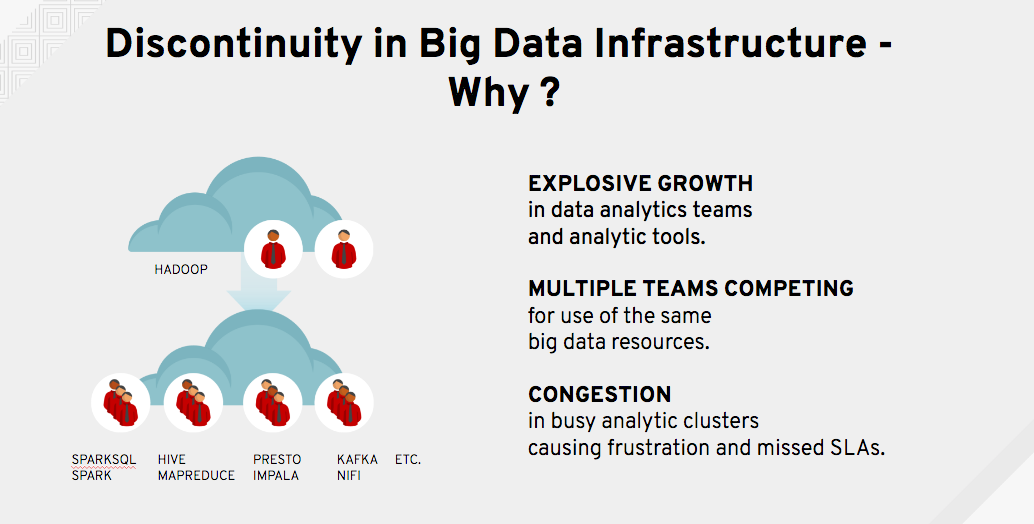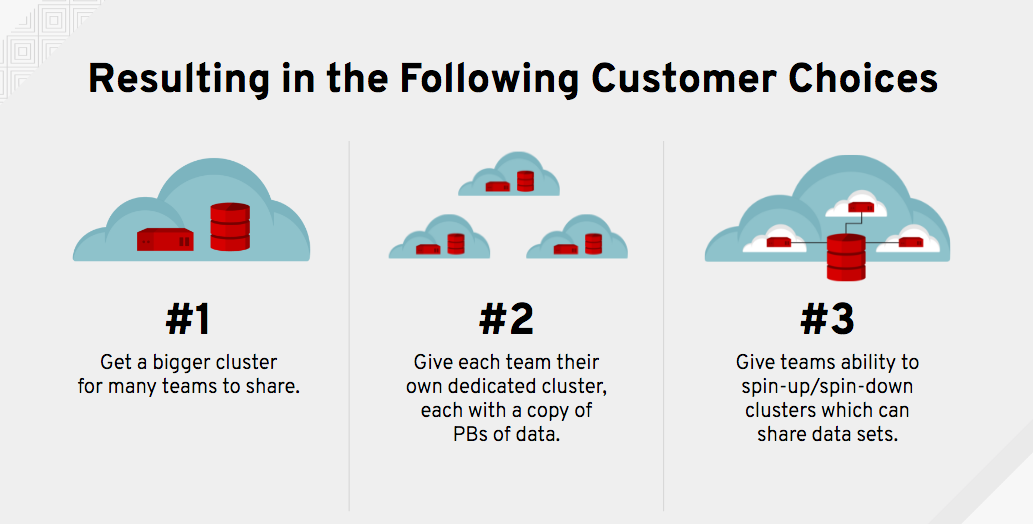A couple years ago, a few big companies began to run Spark and Hadoop analytics clusters using shared Ceph object storage to augment and/or replace HDFS.
We set out to find out why they were doing it and how it performs.
Specifically, we wanted to know first-hand answers to the following three questions:
- Why would companies do this? (this blog post)
- Will mainstream analytics jobs run directly against a Ceph object store? (see "Why Spark on Ceph? (Part 2 of 3)")
- How much slower will it run than natively on HDFS? (see "Why Spark on Ceph? (Part 3 of 3)")
We’ll provide summary-level answers to these questions in a 3-part blog series. In addition, for those wanting more depth, we’ll cross-link to a separate reference architecture blog series providing detailed descriptions, test data, and configuration scenarios, and we recorded this podcast with Intel, in which we talk about our focus on making Spark, Hadoop, and Ceph work better on Intel hardware and helping enterprises scale efficiently.
Part 1: Why would companies do this?
Agility of many, the power of one.
The agility of many analytics clusters, with the power of one shared data store.
(Ok ... enough with the simplistic couplets.)
Here are a few common problems that emerged from speaking with 30+ companies:
- Teams that share the same analytics cluster are frequently frustrated because someone else’s job often prevents their job from finishing on-time.
- In addition, some teams want the stability of older analytic tool versions on their clusters, while their peer teams need to load the latest-and-greatest tool releases.
- As a result, many teams demand their own separate analytics cluster so their jobs aren’t competing for resources with other teams, and so they can tailor their cluster to their own needs.
- However, each separate analytics cluster typically has its own, non-shared HDFS data store - creating data silos.
- And to provide access to the same data sets across the silos, the data platform team frequently copies datasets between the HDFS silos, trying to keep them consistent and up-to-date.
- As a result, companies end up maintaining many separate, fixed analytics clusters (50+ in one case), each with their own HDFS data silo containing redundant copies of PBs of data, while maintaining an error-prone maze of scripts to keep data sets updated across silos.
- But, the resulting cost of maintaining 5, 10, or 20 copies of multi-PB datasets on the various HDFS silos is cost prohibitive to many companies (both CapEx and OpEx).
In pictures, their core problems and resulting options look something like this:
Turns out that the AWS ecosystem built a solution for choice #3 (see Figure 2 above) years ago through the Hadoop S3A filesystem client. In AWS, you can spin-up many analytics clusters on EC2 instances, and share data sets between them on Amazon S3 (e.g. see Cloudera CDH support for Amazon S3). No more lengthy delays hydrating HDFS storage after spinning-up new clusters, or de-staging HDFS data upon cluster termination. With the Hadoop S3A filesystem client, Spark/Hadoop jobs and queries can run directly against data held within a shared S3 data store.
Bottom-line ... more-and-more data scientists and analysts are accustomed to spinning-up analytic clusters quickly on AWS with access to shared data sets, without time-consuming HDFS data-hydration and de-stage cyles, and expect the same capability on-premises.
Ceph is the #1 open-source, private-cloud object storage platform, providing S3-compatible object storage. It was (and is) the natural choice for these companies looking to provide an S3-compatible shared data lake experience to their analysts on-premises.
To learn more, continue to the next post in this series, "Why Spark on Ceph? (Part 2 of 3)": Will mainstream analytics jobs run directly against a Ceph object store?
執筆者紹介
チャンネル別に見る
自動化
テクノロジー、チームおよび環境に関する IT 自動化の最新情報
AI (人工知能)
お客様が AI ワークロードをどこでも自由に実行することを可能にするプラットフォームについてのアップデート
オープン・ハイブリッドクラウド
ハイブリッドクラウドで柔軟に未来を築く方法をご確認ください。
セキュリティ
環境やテクノロジー全体に及ぶリスクを軽減する方法に関する最新情報
エッジコンピューティング
エッジでの運用を単純化するプラットフォームのアップデート
インフラストラクチャ
世界有数のエンタープライズ向け Linux プラットフォームの最新情報
アプリケーション
アプリケーションの最も困難な課題に対する Red Hat ソリューションの詳細
オリジナル番組
エンタープライズ向けテクノロジーのメーカーやリーダーによるストーリー
製品
ツール
試用、購入、販売
コミュニケーション
Red Hat について
エンタープライズ・オープンソース・ソリューションのプロバイダーとして世界をリードする Red Hat は、Linux、クラウド、コンテナ、Kubernetes などのテクノロジーを提供しています。Red Hat は強化されたソリューションを提供し、コアデータセンターからネットワークエッジまで、企業が複数のプラットフォームおよび環境間で容易に運用できるようにしています。
言語を選択してください
Red Hat legal and privacy links
- Red Hat について
- 採用情報
- イベント
- 各国のオフィス
- Red Hat へのお問い合わせ
- Red Hat ブログ
- ダイバーシティ、エクイティ、およびインクルージョン
- Cool Stuff Store
- Red Hat Summit



